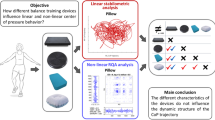Abstract
Paraplegics can maintain a standing posture, called the “C-posture”, while wearing an orthosis. The significant feature of the C-posture is that the body’s center of mass is located behind the hip joint. In this study, we investigate the C-posture mechanism and assess the relationship between posture and stability, the aim being to restore standing function. We first measured the standing postures of paraplegic subjects wearing an orthosis. The subjects maintained the standing posture for 30 s. Next, assuming the C-posture to be an equilibrium attractor in the musculoskeletal system, we used a dynamic model of the musculoskeletal system to analyze the relationship between posture and stability, and also to assess the influence of ankle stiffness. We calculated the standing posture on the basis of a return map. The calculated standing postures show some features of the C-posture. The stability analysis revealed that, despite a limitation in the range of stable postures, the C-posture is more stable than the postures of normal people. The results suggest that although the C-posture is an appropriate posture for paraplegic standing, sufficient ankle stiffness and an appropriate alignment of ankle angle are necessary and preventing hip flexion movements is desirable.










Similar content being viewed by others
References
Dougras R, Larson P, D’Ambrosia R, MCCall R (1983) The LSU reciprocating gait orthosis. Orthopaedics 6:834–838
Gomi H, Osu R (1998) Task-dependent viscoelasticity of human multijoint arm and its spatial characteristics for interaction with environments. J Neurosci 18(21):8965–8978
Harvey L, Herbert R (2002) Muscle stretching for treatment and prevention of contracture in people with spinal cord injury. Spinal Cord 40(1):1–9
Harvey L, Newton-John T, Davis G, Smith M, Engel S (1997) A comparison of the attitude of paraplegic indivisuals to the walkabout orthosis and the isokinetic reciprocal gait orthosis. Spinal Cord 35(9):580–583
Hemami H, Wyman B (1979) Modelling and control of constrained dynamic systems with application to biped locomotion in the frontal plane. IEEE Trans Autom Control 24(4):526–535
Heruti R, Ohry A (2003) Some problems of the lower extremity in patients with spinal cord injuries. Int J Low Extrem Wounds 2(2):99–106
Hogan N (1984) Adaptive control of mechanical impedance by coactivation of antagonist muscles. IEEE Trans Autom Control 29:681–690
Hunt K, Gollee H, Jaime R (2001) Controll of paraplegic angle joint stiffness using FES while standing. Med Eng Phys 23(8):541–555
Jaeger R (1986) Design and simulation of close-loop electrical stimulation orthoses for restoration of quiet standing in paraplegia. J Biomech 19(10):825–835
Jo S, Massaquoi S (2004) A model of cerebellum stabilized and scheduled hybrid long-loop control of upright balance. Biol Cybern 91(3):188–202
Kottke F (1990) Therapeutic exercise to maintain mobility. WB Sunders Company, Philadelphia
\({\text{Matja\v{c}i{\`c}}}\) Z, Bajd T (1998a) Arm free paraplegic standing—Part I. control model synsthesis and simulation. IEEE Trans Rehab Eng 6(2):125–138
\({\text{Matja\v{c}i{\`c}}}\) Z, Bajd T (1998b) Arm free paraplegic standing—Part II. Experimetal result. IEEE Trans Rehab Eng 6(2):139–150
Middleton J, Yeo J, Blanch L, Vare V, Peterson K, Brigden K (1997) Clinical evaluation of a new orthosis, the ‘Walkabout’, for restoration of function standing and short distance mobility in spinal paralyed indivisuals. Spinal Cord 35(9):574–579
Middleton J, Sinclair P, Smith R, Glen M (1999) Postural control during stance in paraplegia: effects of medially linked versus unlinked knee-ankle-foot orthoses. Med Rehabil 80:1558–1565
Rose G (1979) The principles and practice of hip guidance articulations. Prosth Orth Intern 3:37–43
Saitoh E, Suzuki T, Sonoda S, Fujitani J, Tomita Y, Chino N (1996) Clinical experience with a new hip-knee-ankle-foot orthotic system using a medial single hip joint for paraplegic standing and walking. Am J Phys Med Rehabil 75:198–203
van Soest A, Haenen W, Rozendaal L (2003) Stability of bipedal standing: the contribution of cocontraction and spindle feedback. Biol Cybern 88(4):293–301
Winter D, Patla A, Prince F, Ishac M, Gielo-perczak K (1998) Stiffness control of balance in quiet standing. J Neurophysiol 80(3):1211–1221
Yamazaki N (1999) Simulation of body movement. Corona Publishing, Tokyo
Zatsiorsky V, Seluyanov V (1983) The mass and inertia characteristics of the main segment of human body. Human Kinetics, Champaign
Acknowledgments
The authors would like to thank Professors E. Saitoh and M.D. K. Onogi of the Fujita Health University and assistant Professor N. Fukumura of Toyohashi University of Technology for their valuable advice on our study. This study was supported by The New Energy and Industrial Technology Development Organization (NEDO) and the 21st Century COE Program “Intelligent Human Sensing” from the Ministry of Education, Culture, Sports, Science and Technology of Japan.
Author information
Authors and Affiliations
Corresponding author
Additional information
An erratum to this article can be found at http://dx.doi.org/10.1007/s11517-006-0108-3
Rights and permissions
About this article
Cite this article
Kagawa, T., Hiroshi, F. & Yoji, U. Stability analysis of paraplegic standing while wearing an orthosis. Med Bio Eng Comput 44, 907–917 (2006). https://doi.org/10.1007/s11517-006-0087-4
Received:
Accepted:
Published:
Issue Date:
DOI: https://doi.org/10.1007/s11517-006-0087-4




